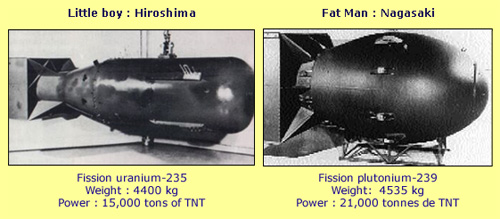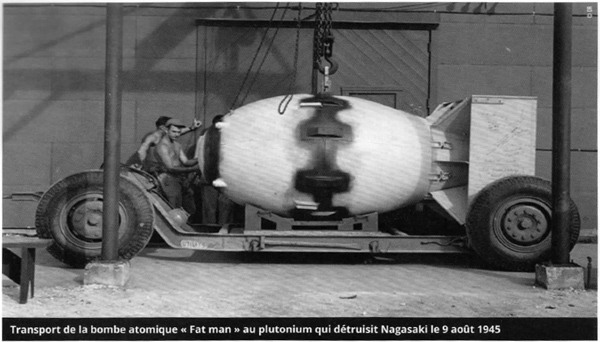Little Boy and Fatman
The United States had available three bombs in July 1945: two made of plutonium and one of uranium. The uranium bomb did not need to be tested due to the simplicity of the firing device. However the finalizing of the plutonium bombs posed technical challenges. It was therefore the plutonium bomb that was used for the first atomic test in on the 16th July 1945 on the site of Alamogordo (code name Trinity) 196km from the South of Albuquerque, in the desert of New Mexico.

The Hiroshima and Nagasaki bombs
The energy of the plutonium bomb dropped on Nagasaki, nicknamed Fat Man, was estimated at 21 kilotons of TNT. A huge fireball was created immediately after the explosion accompanied by a wave of heat and extremely high radioactivity. The strong expansion of the air around the epicenter generated a blast. It was estimated that the energy of the explosion was divided as follows: 35% as heat, 50% for the blast and 15% in the form of radioactive energy.
© DR
The test was conclusive. President Truman received the news at the Potsdam Conference, which was being held at the same time. This enabled him to tell Stalin that the United States had a new and terrifying weapon against Japan.
The uranium bomb was dropped on Hiroshima on the 6th August 1945. Paul Tibbets the pilot of the Enola Gay who drop the bomb, considered in the USA an hero at the time, never expressed during his long life much regret on the death of thousands of innocent victims.
Three days after hHroshima, the 9th August at 11h 02, two B29 bombers, that had flown over the peninsula of Shimamara, arrived above Nagasaki coming from North-East and launched the second plutonium bomb in the North of the city. The bomb dropped from 9600 metres of altitude to explode around 500 metres from ground. That day, the sky was clear; it was quite warm and a calm atmosphere.

Fatman : the Nagasaki bomb
After the Trinity’s test which showed that implosion firing worked for plutonium bombs, the United States had a second bomb, called Fatman, which they dropped on Nagasaki on August 9, 1945.
© Source : Dominique Grenêche – Histoire : développement du nucléaire militaire et civil
At the Nagasaki explosion, the fireball reached a million degrees and its brightness lasted around 10 seconds. It is the infrareds emitted in the first 3 seconds which caused the burns that could be seen on the uncovered parts of the body, up to 4km from the point of impact. These burns were lethal on people who were not sheltered and it is estimated that 20-30 % of the deaths were due to the consequences of these burns.
The thermal rays were reflected by the white parts of an object and absorbed by the black parts. This is what the Doctor Nagai observed when he found the body of the nurse Inouye: “the white parts of the eyes – conjunctivitis- was normal. The black part- the cornea with iris- was burnt and pierced. She was a brave person because she had to directly look at the enemy plane and receive the rays following this event”
The effect of the wind leads to a shock wave or blast, a high pressure wall of air spread itself at the speed of sound or more. The deaths and serious injuries caused by the shock wave mainly came from violent objects and the collapse of buildings.
As well as the above damage, the atomic bomb brought about the curse unknown with conventional bombs of the exposure to radiation. The radiation would have killed a large number of people exposed to an effective dose(whole body) exceeding 4 sieverts, if the majority of people had not already perished beforehand because of the heat, the shock wave and the fires. But the survivors continued to suffer both mentally and physically due to the combination of the radiation and other injuries.
The group of survivors of Hiroshima and Nagasaki which forms the base of the epidemiogical studies conducted on the effect of radiations was defined in1950. The majority of people making up this ‘cohort’ had been exposed to doses probably inferior to one sievert. Five years have elapsed since the bomb, which represent more or less the delay at the end of which long term effects start to show up. The studies do not include the victims that died before 1950 and who suffered the strongest exposures.
Other articles on the subject « Military Applications »
Nuclear Weapons
Atomic and thermonuclear bombs There are two types of nuclear bombs: the atomic A bombs and the t[...]
The Franck Report
The Scientists who opposed dropping atomic bombs on Japan In June 1945, shortly before the atomic[...]
Nagasaki
A Japanese account of the Nagasaki bomb Atomic bomb, rescue and relief report, a poignant small b[...]
Nagasaki First Aid
Extracts from Doctor Takashi Nagai first report In this first rescue report intended for the auth[...]
Atoms for Peace
1953: Eisenhower’s initiative for peaceful use of the atom After the Second World War, The [...]
Testing Nuclear Weapons
A practice that culminates in the 1950’s and 1960’s… The nuclear tests conducted by the sup[...]
Atomic Tests Fallout
An embarrassing legacy but alleviated with time Radioactive fallout differ significantly accordin[...]
Arsenals reduction
A modest step towards a reduction in nuclear arsenals During the Cold War, the United States and [...]